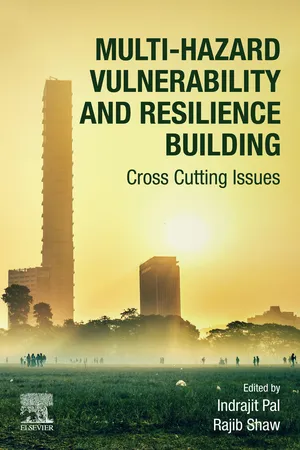
Multi-Hazard Vulnerability and Resilience Building
Cross Cutting Issues
- 412 pages
- English
- ePUB (mobile friendly)
- Available on iOS & Android
About This Book
Multi-hazard Vulnerability and Resilience Building: Cross Cutting Issues presents multi-disciplinary issues facing disaster risk reduction and sustainable development, focusing on various dimensions of existing and future risk scenarios and highlighting concerted efforts of scientific communities to find new adaptation methods. Disaster risk reduction and resilience requires participation of a wide array of stakeholders, ranging from academicians to policy makers to disaster managers. The book offers evidence-based, problem-solving techniques from social, natural, engineering, and other perspectives, and connects data, research, and conceptual work with practical cases on disaster risk management to capture multi-sectoral aspects of disaster resilience, adaptation strategy, and sustainability.
- Provides foundational knowledge on integrated disaster vulnerability and resilience building
- Brings together disaster risk reduction and resilience scientists, policy-makers, and practitioners from different disciplines
- Includes case studies on disaster resilience and sustainable development from a multi-disciplinary perspective
Frequently asked questions
Information
Table of contents
- Cover image
- Title page
- Table of Contents
- Copyright
- List of contributors
- Chapter 1. An overview of vulnerability and resilience building in the Asia Pacific region
- Chapter 2. Opportunities and challenges farmers face when Using indigenous knowledge to adapt to climate change in sustainable development in Mekong Delta, Vietnam (A case study in An Giang province)
- Chapter 3. Development of a disaster and climate risk ATLAS in Bangladesh: Methodology for quantification of risk
- Chapter 4. Sustainability assessment methodology for residential building in urban area—a case study
- Chapter 5. Comparison of the vulnerability assessment of step-back configuration and set-back configuration structures on hill slopes
- Chapter 6. A proposal for disaster risk management in the local level: lesson learned from earthquake prone area in Sengon village, Central Java, Indonesia
- Chapter 7. Community resilience for disaster risk reduction by engaging local governance in Bihar (India)
- Chapter 8. A working strategy for preparedness in Kerala schools: a suggestive study
- Chapter 9. Integrating indigenous knowledge with science to suitably tackle disasters due to climate and environmental change: an overview of the progress and way forward
- Chapter 10. Target E of Sendai Framework: current status and how to complete by 2022 end
- Chapter 11. Predict the critical load of rectangular concrete-filled steel tube columns with ultra high strength concrete with software ANSYS
- Chapter 12. Time-dependent reliability system of the continuous steel beam I-shapes with corrosion damage
- Chapter 13. An extensive study on damage assessment of earthquake-affected buildings in Nepal
- Chapter 14. Modeling soil erosion: Samanalawewa watershed, Sri Lanka
- Chapter 15. Efficient earthquake intensity measures for probabilistic seismic demand models of skewed RC bridges
- Chapter 16. Time-frequency analysis of ground motions from the 1999 Chamoli earthquake
- Chapter 17. Mainstreaming disaster risk management technical and vocational education and training (DRM-TVET) program in higher education institutions: flexible ladderized capacity building model amid COVID-19
- Chapter 18. Extreme flood analysis for Lower Indus Basin, Pakistan study under disaster risk reduction
- Chapter 19. Change in cropping pattern and soil health in relation to climate change and salinity in coastal Bangladesh
- Chapter 20. Strengthening capacity for disaster resilience of rural women in Fiji
- Chapter 21. Foundation of indigenous knowledge theory for disaster risk reduction
- Chapter 22. Critical infrastructure resilience in Eastern Economic Corridor of Thailand—a review
- Index